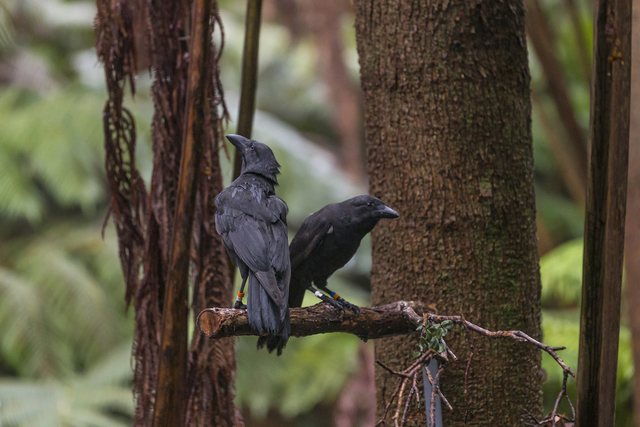Less than two weeks after a small cohort of captive-bred ‘alala, endangered Hawaiian crows, was released into the wild, two of the five birds were returned to an outdoor aviary.
Less than two weeks after a small cohort of captive-bred ‘alala, endangered Hawaiian crows, was released into the wild, two of the five birds were returned to an outdoor aviary.
The remaining three birds were found dead during the past week, according to a release from the state Department of Land and Natural Resources.
The cause of death is not yet known, and necropsies will be performed on the birds to learn more.
Officials said the birds “had been observed doing well and eating from feeders placed in the area.” The ‘alala were released Dec. 14 into the Pu‘u Maka‘ala Natural Area Reserve.
DLNR wildlife biologist John Vetter said in a statement that some level of mortality during reintroduction is to be expected.
“We were prepared for that possibility,” he said. “The initial days of release are always the most difficult stage of any release program, and the level of uncertainty is also highest with the first release cohort.”
The ‘alala breeding program is a joint effort of the DLNR, the U.S. Fish and Wildlife Service and San Diego Zoo Global. It is one of several bird species reintroduction efforts taking place at San Diego Zoo Global’s Hawaii Endangered Bird Conservation Program.
The ‘alala has been extinct in the wild since 2002. In the 1990s, attempts were made to reintroduce captive-raised birds to the wild. That group of birds also suffered a high mortality rate because of disease and predation.
San Diego Global spokeswoman Christina Simmons said in an email to the Tribune-Herald that full necropsies can take several weeks to complete.
“It does also sometimes occur that we do not get a definitive answer regarding the cause of death,” she said.
“The loss of these three birds is difficult for the entire community, including the many people who have cared for these birds since their hatch and have worked steadfastly to prepare for their release,” said HEBCP conservation program manager Bryce Masuda.
San Diego Global worked on another captive bird breeding program in the 1990s: the reintroduction of the California condor to the wild. Simmons said that project, though ultimately successful, also struggled in its early days.
The condor experience “reminds us that there will be ups and downs as we try to do something that has never been done before,” she said. “We are not giving up.”
Email Ivy Ashe at iashe@hawaiitribune-herald.com.




